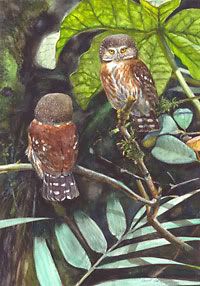
E: Environment, Enrichment,
Education, & Endangered Species
All content © by Diana L. Guerrero unless otherwise noted and may not be reprinted without prior written permission. All rights reserved. Click here for reprint permissions and fees.
The Pernambuco Pygmy Owl is found in the Reserva Biológica de Saltinho, a protected area of old secondary forests and high in the canopy in Usina Trapiche, Sirinhaéml. Both reserves are in Pernambuco, Brazil. Of the original 15,277 square miles/39,567 km2 of original forest of the Pernambuco Center, only 736 square miles/1,907 km2 (5 percent) are left. The remaining forest is fragmented in more than 1,400 parcels most of which are less than 100 hectares (247 acres) and are surrounded by agricultural and urban development. This discovery was published in Ararajuba: the Brazilian Journal of Ornithology. December 2002. 10 (2): 123-130. Discovered on the brink of extinction: a new species of Pygmy-Owl (Strigidae: Glaucidium) from Atlantic Forest of northeastern Brazil by Luis Pedreira Gonzaga, José Maria Cardoso da Silva and Galileu Coelho. Thanks to Conservation International and Birdlife International for their press releases and photos.
Animal of the Month
Pernambuco Pygmy Owl
(Glaucidium mooreorum)
The Pernambuco Pygmy Owl (Glaucidium mooreorum) was first described in December 2002. The tiny owl, measuring 6 inches from bill to tail and weighing a mere 2 ounces, was found in fragmented secondary forest in Pernambuco state in northeastern Brazil.
The three scientists responsible for the study named the owl after Intel founder, Gordon Moore and his wife, Betty for their contributions to biodiversity conservation.
The owl was first recorded in 1990 by Galileu Coelho, a professor at the Federal University of Pernambuco, who did not realize it was a distinct species. It was only in 2000 when José Maria Cardoso da Silva, of Conservation International Brazil, came across the stored specimen in a bird collection and compared it with similar species, that he concluded it was indeed new to science. After analyzing the bird's song against those of other species, Luiz Pedreira Gonzaga of the Federal University of Rio de Janeiro supported Cardoso da Silva's hypothesis.
Gustavo Fonseca, CI's Executive Vice President for Programs and Science said, "despite being so new to science, enough evidence exists to rank the pygmy-owl as critically endangered according to the World Conservation (IUCN) Red List guidelines."
In addition, the Atlantic Forest biodiversity hotspot in which the bird occurs is one of the most threatened in the world. Considered one of the "hottest of the hotspots," this region has some of the most unique biodiversity in the world and is also at high risk of losing it unless immediate conservation action is taken. Less than 10 percent of the Atlantic Forests' original vegetation remains. In an area 50 times smaller than the Brazilian Amazon, it holds an incredible 20,000 plant species, 40 percent of which are found no where else. Combined, the 25 global biodiversity hotspots contain 60 percent of terrestrial plant and animal species in only 1.4 percent of the planet's land area.
The new species has been seen in only two locations in Pernambuco making it even more critical that its habitat be protected. Researchers warn its range is limited, its habitat severely fragmented and in a state of continuing decline due to unchecked human activities in the region.
The area in which the pygmy-owl lives harbors half of the 850 bird species that exist in the Atlantic Forest, with 17 globally threatened species and one extinct in the wild, the Mitu mitu. The region has one of the highest numbers of threatened species in all of South America.
"Urgent conservation action is needed if we are to save the pygmy-owl and the other species in this forest," said Marcelo Tabarelli, director of The Environmental Research Center of the Northeast Brazil (CEPAN). "Until now, protected areas have been too small and fragmented for effective forest maintenance and regeneration. A minimum level of landscape connectivity is necessary to promote key ecological processes," he said.
Conservationists have recommended a regional strategy that includes forest restoration and the establishment of ecological corridors to connect remaining forest fragments.
"Pernambuco Center is the most critical bio-geographical region in all of the Atlantic Forest," said Luiz Paulo Pinto, Conservation International's Director for the Atlantic Forest. "The implementation of a biodiversity corridor in this area will require immediate action at different levels, using scientific information and building alliances with several sectors of society."
The new owl species is closely related to the Amazonian pygmy-owl (Glaucidium hardyi) and the least pygmy-owl (Glaucidium minutissimum) from southeastern Brazil, but differs by the coloration of its plumage, its shape and its vocalization. The crown of Glaucidium mooreorum is dark brown with white spots; the back is dark reddish brown; the tail is dark brown with five horizontal white bands that appear as irregular white spots; the abdomen is white with light reddish brown streaks.
About the columnist: Since 1978 Diana L. Guerrero has worked professionally with both wild and domestic animals. Guerrero has been affiliated with, and certified by, a variety of animal programs in the USA and Europe. Based in California, she writes, consults, and speaks. Information on her animal career programs, training courses, and her books {What Animals Can Teach Us about Spirituality (SkyLight Paths, 2003), Blessing of the Animals (Sterling, 2007), Help! My Pet is Driving Me Crazy (Guerrero Ink, 2007), Animal Disaster Preparedness for Pet Owners & Pet Professionals (Guerrero Ink, 2007)} can be found in this web site and in the shop. Questions for Guerrero should be submitted via the blog comments or membership forum.





